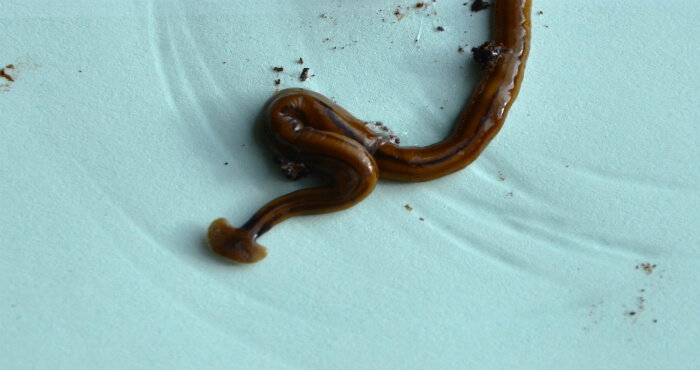
Environmental officials warn about another strange creature in the Commonwealth.
MIDLOTHIAN- First, there were murder hornets. Then, there were puss caterpillars. Now, some more creepy, crawly guests are showing up in the Commonwealth- an invasive species of flatworm that can grow to be a foot long. This creature is called the “hammerhead flatworm”, named after the distinct shape of its head. Usually, they live in Southeast Asia, but recently one was found slithering in Virginia.
READ MORE: Move Over Murder Hornets. Venomous ‘Puss Caterpillars’ Are Taking Over.
Originally, they thought it was a snake due to its impressive length. So, they called in a report to the Virginia Wildlife Management and Control Center. At first, their staff had no clue what it was. In a now deleted Facebook post, center officials asked the public if they knew what kind of snake it was.
“The problem is, we’ve never seen anything like it before, and we’re not sure if it’s a freak of nature,” the company wrote. It wasn’t until days later that they knew it was an invasive species of worm. In another deleted post, they finally confirmed the worm’s identity.
What is This Worm Doing in Virginia?
The hammerhead flatworm, also known as the ribbon worm, has actually been in the United States for a while. In fact, they’ve been reported in the country for over 100 years. Eric Day, the manager of the insect lab at Virginia Tech, is very familiar with the worm.
“I’ve been in Virginia for over 34 years and I’ve seen them as long as I’ve been here,” said Day. According to Day, the number of hammerheads aren’t growing. Usually, the hammerhead flatworm likes hot and humid environments, like in eastern Virginia. So far, there’s been sightings of this kind of worm in other Southern states, but they’re still considered very rare in Virginia. however, this isn’t the first time a hammerhead flatworm has been found in the Old Dominion.
Five years ago, a Virginia Beach woman found a 14-inch one around her home in Little Neck. According to reports from the Virginian Pilot, Diane McClernon found the worm in her backyard, crawling across her patio.
“It has an anvil-shaped head and is iridescent greenish- brown with a flat belly of a lighter color,” McClernon wrote. “WEIRD!” While they’ve been in the country for decades, they’re still pretty uncommon in Virginia.
Where are they coming from? Well, entomologists aren’t entirely sure. But, Day says they’re probably spreading around via potted plants. Basically, people buy potted plants that contain a worm and accidentally bring it home.
Is it Dangerous?
While it is a little alarming in appearance, these worms are not dangerous to humans or pets. In fact, they’re only a danger to earthworms, which they love to eat. However, if you see one in the wild, do not cut it in half. Just like the hydra from Greek Mythology, if you cut this worm in half, another worm grows back in it’s place. Some sources say this makes them “essentially” immortal.
Unlike other flatworms, these worms are not parasitic. According to Day, it’s a “terrestrial flatworm”, meaning that it lives in the dirt.
When it comes to their effect on the environment, there’s not much known. However, Day says that their effect on the environment is relatively small. Since there aren’t very many of them, it’s not likely that they’re causing much havoc on Virginia’s ecosystem. However, there has not been a survey on their population done yet, so it’s hard to say for sure.
“The numbers don’t seem to get too outrageous. They might be a problem for earthworms or other soil dwelling arthropods,” said Day. “But, because of their low numbers, I don’t think of them has having a very high impact.”
What Should You Do if You See One?
If you see one, don’t panic. These worms are harmless. But, if you find one in a potted plant, it’s super important that you don’t move that plant. As stated earlier, that’s the most popular way that they spread. And while their effect on the environment is minimal, they’re still an invasive species and shouldn’t be spread if it can be avoided.
“The main thing here is to not move that plant around if you find a worm,” said Day. “Because they usually spread through potted plants.”
If you want to get rid of one, Day says to try salt.
“Anything that you would use for slug control would work for these things,” said Day. “I would try slug control or if you’re away from plants, I’d pour some salt on them.
Not sure if you found a hammerhead flatworm? Day recommends taking a picture of it and sending it to your local Wildlife Management team.
Arianna Coghill is a content producer with the Dogwood. You can reach her at [email protected]
Politics

Opinion: The problem with Youngkin’s Charter-Lab schools push in 2024
The Problem Governor Glenn Youngkin introduced 233 amendments to the bipartisan budget so it was hard to know how to assess his budget–for example,...

What to know about Trump’s legal issues
Over the past year, former president Donald Trump has become the center of not one, not two, not three, but four criminal investigations, at both...
Local News

Virginia verses: Celebrating 5 poetic icons for National Poetry Month
There’s no shortage of great writers when it comes to our commonwealth. From the haunting verses of Edgar Allan Poe, who found solace in Richmond's...

Join the fun: Recapping Family Literacy Night’s storybook adventures
When’s the last time you read a book aloud with a loved one? If it’s difficult to answer that question, then maybe it’s time to dust off that TBR...




